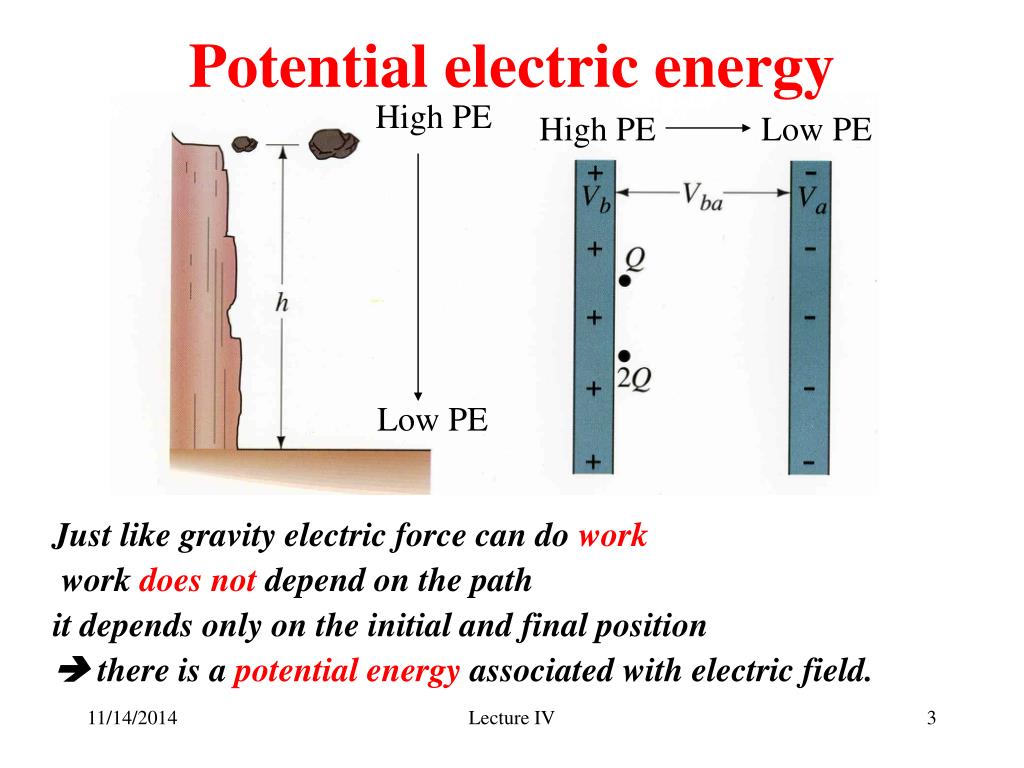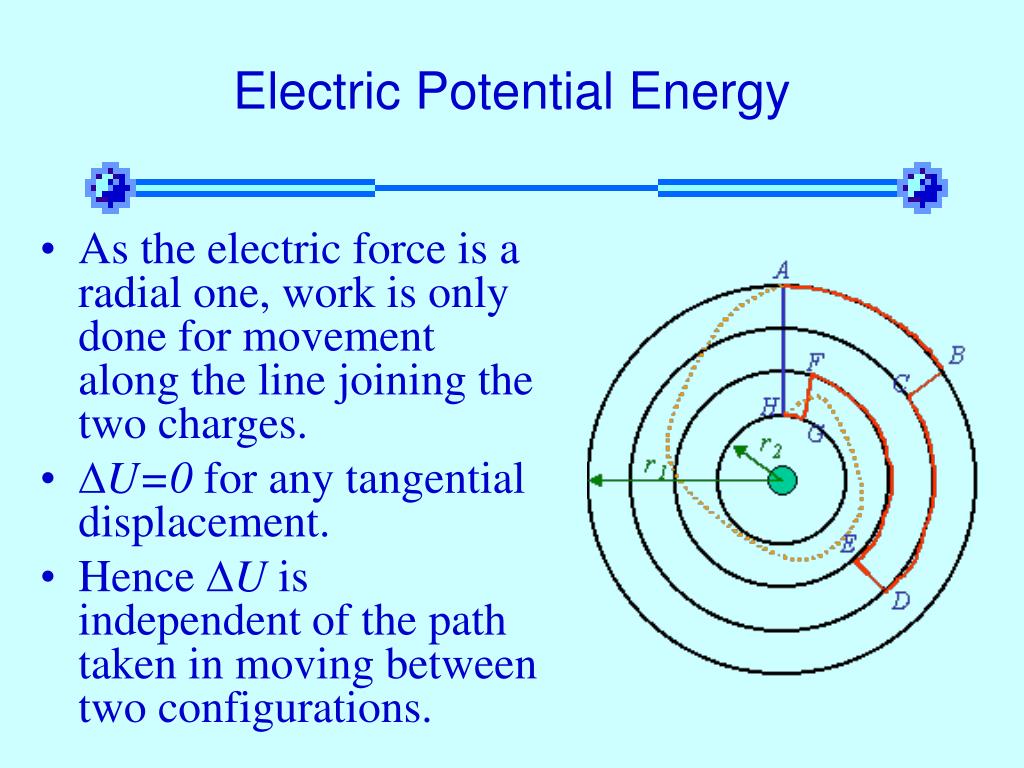- Home
- Electrical Potential Energy
Electrical Potential Energy
September 29, 2022
Electric potential - Wikipedia
In short, an electric potential is the electric potential energy per unit charge. This value can be calculated in either a static (time-invariant) or a dynamic (time-varying) electric field at a specific time with the unit joules per coulomb (J⋅C −1) or volt (V). The electric potential at infinity is assumed to be zero

Electric Potential Energy - Formula, Definition, Solved Examples - BYJUS
Electric potential energy is a scalar quantity and possesses only magnitude and no direction. It is measured in terms of Joules and is denoted by V. It has the dimensional formula of ML 2 T -3 A -1. There are two key elements on which the electric potential energy of an object depends. It's own electric charge
Electric potential energy - Wikipedia
Electric potential energy is a potential energy (measured in joules) that results from conservative Coulomb forces and is associated with the configuration of a particular set of point charges within a defined system
7.1 Electric Potential Energy - University Physics Volume 2
When a free positive charge q is accelerated by an electric field, it is given kinetic energy ().The process is analogous to an object being accelerated by a gravitational field, as if the charge were going down an electrical hill where its electric potential energy is converted into kinetic energy, although of course the sources of the forces are very different
Electric Potential Energy | Definition, Formula & Calculation - Magnetism
Electric potential, denoted by V (or occasionally φ), is a scalar physical quantity that describes the potential energy of a unit electric charge in an electrostatic field. Va = Ua/q It is defined as the amount of work energy needed to move a unit of electric charge from a reference point to a specific point in an electric field

Electric potential energy (video) | Khan Academy
Well, all of this electrical potential energy is going to be converted to kinetic energy. So essentially, we have 30 joules is going to be equal to 1/2 mv squared, right? We know the mass, I said, is 1, so we get 60 is equal to v squared, so the velocity is the square root of 60, so it's 7 point something, something, something meters per second
7.1 Electric Potential Energy - University Physics Volume 2 - OpenStax
We call this potential energy the electrical potential energy of Q. Figure 7.3 Displacement of "test" charge Q in the presence of fixed "source" charge q . The work W 12 W 12 done by the applied force F → F → when the particle moves from P 1 P 1 to P 2 P 2 may be calculated by
19 Examples Of Electric Potential Energy: Detailed Facts
A beneficial mode of potential energy is electric potential energy which is essential in our daily lives. Electronic devices are possessed with electric potential energy. Electric potential energy is essential for the conduction of electricity. Here are some examples of electric potential energy are discussed in this article
Electric potential (article) | Khan Academy
The electric potential, or voltage, is the difference in potential energy per unit charge between two locations in an electric field. When we talked about electric field, we chose a location and then asked what the electric force would do to an imaginary positively charged particle if we put one there

Electric Potential & Electric Potential Energy | Open Physics ... - Medium
Electric Potential. Electric potential is the electric potential energy per unit charge. The electric potential V is the potential energy of 1 coulomb charge. potential energy of q0 is U . So
Potential energy - Wikipedia
Common types of potential energy include the gravitational potential energy of an object that depends on its mass and its distance from the center of mass of another object, the elastic potential energy of an extended spring, and the electric potential energy of an electric charge in an electric field
What is Electric Potential Energy : Working & Its Applications - ElProCus
The electric potential energy of an object mainly depends on two main elements like its own electric charge and relative location through other objects which are electrically charged. This is a scalar quantity that can be measured in terms of Joules & denoted by V, ΔV, ΔU & U. The dimensional formula of electric potential energy is ML^2T^-3A^-1
What is Electric Potential Energy? -
In order to calculate electric potential energy of two particles at a given point, the electric potential energy formula (or electric potential energy equation) is used. This factors in the

19.1 Electric Potential Energy: Potential Difference - OpenStax
Gravitational potential energy and electric potential energy are quite analogous. Potential energy accounts for work done by a conservative force and gives added insight regarding energy and energy transformation without the necessity of dealing with the force directly. It is much more common, for example, to use the concept of voltage (related
Electric potential energy - study notes -
Electrical potential energy - concepts. The electric potential energy of a charge at any point, E P, is the amount of energy needed to bring the charge from infinity to that point.; When charges are moved in electric fields energy is transferred (work is done), unless the movement is perpendicular to the direction of the force (and field)
Electric potential energy of charges (video) | Khan Academy
So to find the electrical potential energy between two charges, we take K, the electric constant, multiplied by one of the charges, and then multiplied by the other charge, and then we divide by the distance between those two charges. We'll call that r. So this is the center to center distance. It would be from the center of one charge to the
Electric Potential and Electric Potential Energy :: Physics Tutorials
Electric potential is the electric potential energy per unit charge. It is known as voltage in general, represented by V and has unit volt (joule/C). 1C charge is brought to the point A from infinity. Work done here is called potential of q at A. Electric potential is found by the given formula; V=k.q/d V is a scalar quantity

UNIT 22 - Electric Potential Energy, and Electric Potential
Last Update: 06/24/2022. electric potential energy. The electrostatic or Coulomb force is conservative. This means that when negative work done by the Coulomb force removes kinetic energy from the system, that energy is stored in the form of electric potential energy, and can be converted back into kinetic energy again when the Coulomb force does positive work
Electric potential, voltage (article) | Khan Academy
Electric potential energy is a property of a charged object, by virtue of its location in an electric field. Electric potential energy exists if there is a charged object at the location. Electric potential difference, also known as voltage, is the external work needed to bring a charge from one location to another location in an electric field
Force and Potential Energy: Relation & Types | StudySmarter
Types of Forces that Provide Potential Energy. A few common conservative forces we use in physics problems are the force of gravity, the spring force, and the electric mentioned above, when these forces act on objects in a system, the system has potential energy
Electric potential energy - GSU
Electric Potential Energy. Potential energy can be defined as the capacity for doing work which arises from position or configuration. In the electrical case, a charge will exert a force on any other charge and potential energy arises from any collection of charges. For example, if a positive charge Q is fixed at some point in space, any other

Electrostatic Potential Energy - GeeksforGeeks
Electric potential energy is a scalar quantity with no direction and only magnitude. It is symbolized by V and has the dimensional formula ML 2 T -3 A -1. Work done on a test charge q by the electrostatic field due to any given charge configuration is independent of the path and depends only on its initial and final positions
Activity 2: Electric potential and potential energy |
Physics questions and answers. Activity 2: Electric potential and potential energy of the electric quadrupole Let us re-examine the electric quadrupole that we have seen before. This time, we are interested in the work that would be required to assemble this charge configuration. Figure 1: The electric quadruple. 1
Post a Comment
Note: Only a member of this blog may post a comment.